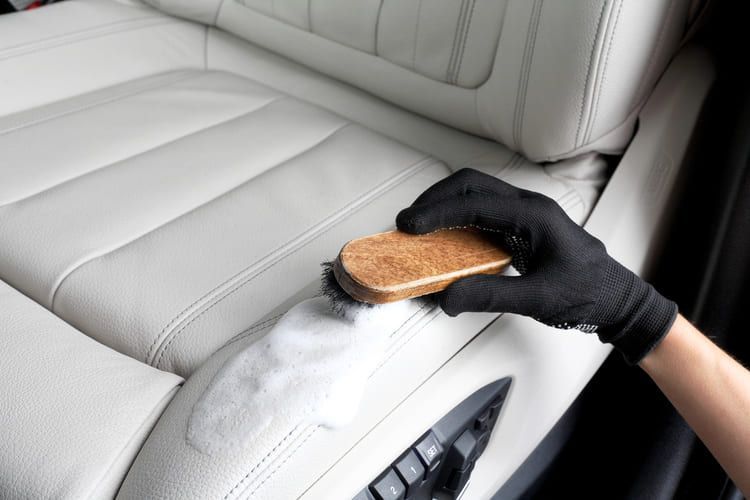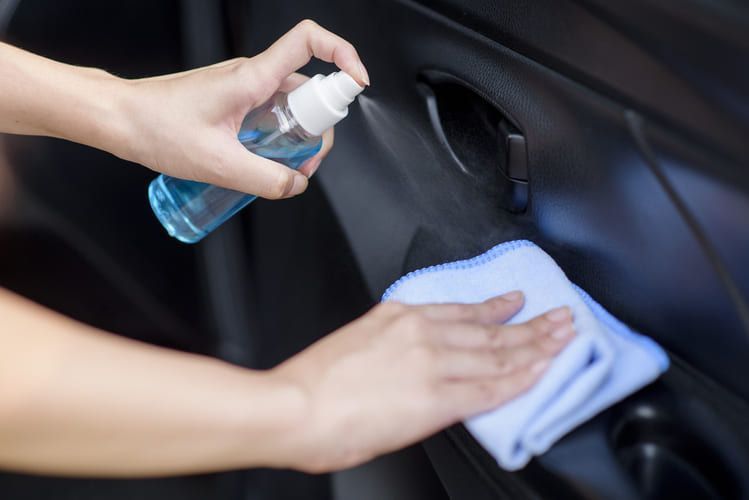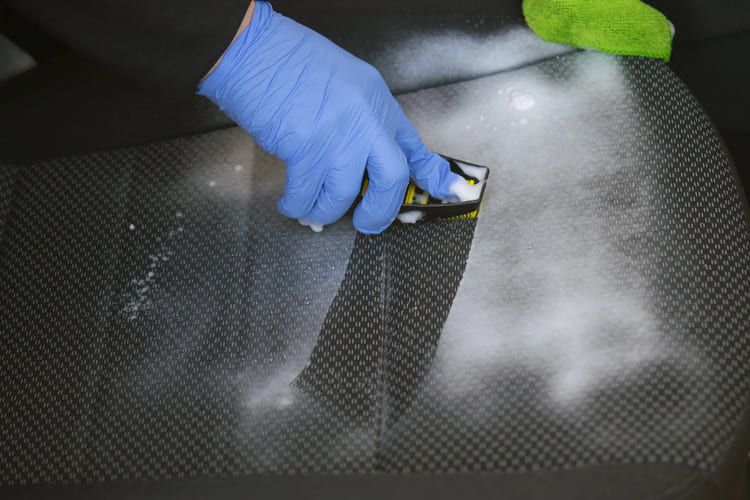How to Remove Stubborn
Stains from Car Upholstery
Published on: 12th August 2024
How to Remove Stubborn
Stains from Car Upholstery
Published on: 12th August 2024
Introduction
Stains on your car’s upholstery can be frustrating and unsightly, diminishing the overall appeal of your vehicle's interior. Whether it’s coffee spills, pet accidents, or mud tracked in from the outside, removing stubborn stains requires the right techniques and products. In this comprehensive guide, we'll walk you through effective methods to tackle even the most persistent stains, helping you restore your car’s interior to its pristine condition. For those in Wakefield, utilising services like car valeting near Wakefield can also provide professional assistance in keeping your car spotless.

1. Understanding the Type of Stain
Before you begin tackling any stain, it's crucial to identify what type of stain you're dealing with. Different stains require different approaches for effective removal.
- Water-Based Stains: These include spills like coffee, juice, or soda. They are generally easier to remove because they dissolve in water.
- Oil-Based Stains: Grease, food, and some makeup products fall into this category. They require a different approach because they don’t dissolve in water.
- Organic Stains: These include blood, vomit, and food spills. They can be tricky because they might leave a residue that attracts dirt if not cleaned properly.
- Ink and Dye Stains: Ink from pens or dye from clothes can be stubborn and often require specialised products to remove completely.
For more tips on interior maintenance, check out our
Best Practices for Maintaining Your Car's Interior
blog page.
2. Pre-Treatment Steps
Before applying any cleaning product, it's essential to prepare the stained area. Proper preparation ensures that the cleaning process is more effective.

- Vacuum the Area: Start by vacuuming the stained area to remove any loose dirt or debris. This step prevents the dirt from being rubbed into the fabric during cleaning.
- Test the Cleaner: Always test your cleaning product on an inconspicuous area of the upholstery first. This ensures it doesn’t cause discolouration or damage.
- Blot the Stain: If the stain is fresh, blot it with a microfibre cloth to absorb as much of the spill as possible. Avoid rubbing, as this can push the stain deeper into the fabric.
For more detailed cleaning instructions, visit our DIY vs. Professional Car Care: What's Right for You? blog page.
2. Pre-Treatment Steps
Before applying any cleaning product, it's essential to prepare the stained area. Proper preparation ensures that the cleaning process is more effective.
- Vacuum the Area: Start by vacuuming the stained area to remove any loose dirt or debris. This step prevents the dirt from being rubbed into the fabric during cleaning.
- Test the Cleaner: Always test your cleaning product on an inconspicuous area of the upholstery first. This ensures it doesn’t cause discolouration or damage.
- Blot the Stain: If the stain is fresh, blot it with a microfibre cloth to absorb as much of the spill as possible. Avoid rubbing, as this can push the stain deeper into the fabric.
For more detailed cleaning instructions, visit our DIY vs. Professional Car Care: What's Right for You? blog page.

3. Removing Common Stains from Fabric Upholstery
Fabric upholstery is prone to a variety of stains, from food spills to mud. Here’s how to effectively remove these common stains.
- Coffee and Tea: Blot the area with a microfibre cloth, then apply an upholstery cleaner directly to the stain. Gently work it into the fabric with a soft-bristle brush, then blot with a clean cloth.
- Food and Beverage Stains: For food and drink spills, mix a solution of mild detergent and water. Apply it to the stain and gently scrub with a soft brush. Rinse with a damp cloth and blot dry.
- Mud and Dirt: Allow the mud to dry completely before vacuuming the area. Then, use an upholstery cleaner to remove any remaining residue.
4. Dealing with Pet Stains and Odours
Pet stains, whether from accidents or muddy paws, can be particularly challenging. In addition to the stain itself, pet odours can linger if not treated properly.
- Blot the Area: For fresh accidents, blot up as much liquid as possible with a microfibre cloth.
- Enzymatic Cleaners: Use an enzymatic cleaner specifically designed for pet stains. These cleaners break down the proteins in the stain, effectively removing both the stain and the odour.
- Odour Neutralisers: After cleaning, use an odour neutraliser to ensure the smell doesn’t linger. This is especially important in preventing pets from soiling the same spot again.
If you're struggling with pet hair and stubborn stains in your car, this comprehensive guide on Pet Hair and Dirt Removal offers effective solutions to keep your interior spotless.

4. Dealing with Pet Stains and Odours
Pet stains, whether from accidents or muddy paws, can be particularly challenging. In addition to the stain itself, pet odours can linger if not treated properly.

- Blot the Area: For fresh accidents, blot up as much liquid as possible with a microfibre cloth.
- Enzymatic Cleaners: Use an enzymatic cleaner specifically designed for pet stains. These cleaners break down the proteins in the stain, effectively removing both the stain and the odour.
- Odour Neutralisers: After cleaning, use an odour neutraliser to ensure the smell doesn’t linger. This is especially important in preventing pets from soiling the same spot again.
If you're struggling with pet hair and stubborn stains in your car, this comprehensive guide on Pet Hair and Dirt Removal offers effective solutions to keep your interior spotless.
5. Handling Tough Grease and Oil Stains
Grease and oil stains are among the most difficult to remove from car upholstery. However, with the right approach, you can effectively tackle these tough stains.
- Absorb the Oil: Begin by sprinkling baking soda or cornflour on the stain to absorb as much oil as possible. Let it sit for at least 15 minutes before brushing it off.
- Apply a Degreaser: Use a degreaser or an upholstery cleaner designed for grease removal. Apply it to the stain and gently work it into the fabric with a soft brush.
- Rinse and Blot: After treating the stain, rinse the area with a damp cloth and blot dry with a clean microfibre cloth.

5. Handling Tough Grease and Oil Stains
Grease and oil stains are among the most difficult to remove from car upholstery. However, with the right approach, you can effectively tackle these tough stains.

- Absorb the Oil: Begin by sprinkling baking soda or cornflour on the stain to absorb as much oil as possible. Let it sit for at least 15 minutes before brushing it off.
- Apply a Degreaser: Use a degreaser or an upholstery cleaner designed for grease removal. Apply it to the stain and gently work it into the fabric with a soft brush.
- Rinse and Blot:
After treating the stain, rinse the area with a damp cloth and blot dry with a clean microfibre cloth.
6. Final Steps: Drying and Odour Control
Once you’ve successfully removed the stain, it’s important to ensure the area is thoroughly dried and any lingering odours are eliminated.
- Dry the Area: Use a clean, dry microfibre cloth to blot the area and remove as much moisture as possible. If the stain was particularly wet, consider using a portable fan to speed up the drying process.
- Odour Removal: Even after the stain is gone, some odours can linger. Use an odour neutraliser or a mixture of vinegar and water to lightly mist the area and eliminate any remaining smells.
- Final Vacuum: Once the area is dry, give it a final vacuum to restore the texture of the fabric and ensure all cleaning residue is removed.
If your car's interior has gotten wet, this helpful guide on How to Dry Your Car Interior After Rain provides practical tips to prevent damage and restore comfort.
7. Preventing Future Stains
Preventing stains is easier than removing them, so consider taking proactive steps to protect your car’s upholstery.

- Use Seat Covers: Seat covers are an effective way to protect your upholstery from spills, stains, and general wear and tear. They’re especially useful if you frequently travel with children or pets.
- Regular Cleaning: Regularly vacuum and clean your car’s interior to prevent dirt and stains from building up. Quick attention to spills can prevent them from becoming stubborn stains.
- Protective Sprays:
Consider using a fabric protector spray that creates a barrier against spills and stains. These sprays can make it easier to clean up messes before they set into the fabric.
7. Preventing Future Stains
Preventing stains is easier than removing them, so consider taking proactive steps to protect your car’s upholstery.
- Use Seat Covers: Seat covers are an effective way to protect your upholstery from spills, stains, and general wear and tear. They’re especially useful if you frequently travel with children or pets.
- Regular Cleaning: Regularly vacuum and clean your car’s interior to prevent dirt and stains from building up. Quick attention to spills can prevent them from becoming stubborn stains.
- Protective Sprays: Consider using a fabric protector spray that creates a barrier against spills and stains. These sprays can make it easier to clean up messes before they set into the fabric.

8. When to Seek Professional Help
Sometimes, stains are too stubborn or extensive to remove on your own. In such cases, it’s best to seek professional help to avoid damaging your upholstery.
- Deep Stains: For deeply ingrained stains or large areas affected, a professional car valeting service can provide the expertise and specialised equipment needed for effective removal.
- Sensitive Materials: If your car has delicate or expensive upholstery, such as suede or alcantara, professional cleaning ensures that these materials are treated properly without causing damage.
- Odour Issues: Persistent odours that don’t respond to regular cleaning methods may require professional odour removal techniques.
If you’re dealing with a particularly tough stain or need comprehensive cleaning, explore our
Benefits of Regularly Using a Car Valeting Service Near Me
page for professional assistance.
9. Conclusion
Removing stubborn stains from car upholstery doesn’t have to be a daunting task. By understanding the type of stain, using the right products and techniques, and following up with proper drying and odour control, you can restore your car’s interior to its original condition. Regular maintenance and preventative measures can also help to keep your upholstery looking fresh and clean. For those in Wakefield seeking professional assistance, our range of car valeting and detailing services are designed to tackle even the most challenging stains, ensuring your vehicle remains spotless.
Take the next step to giving your car the care it deserves. Click below to book your stain removal or full car valeting service today!
